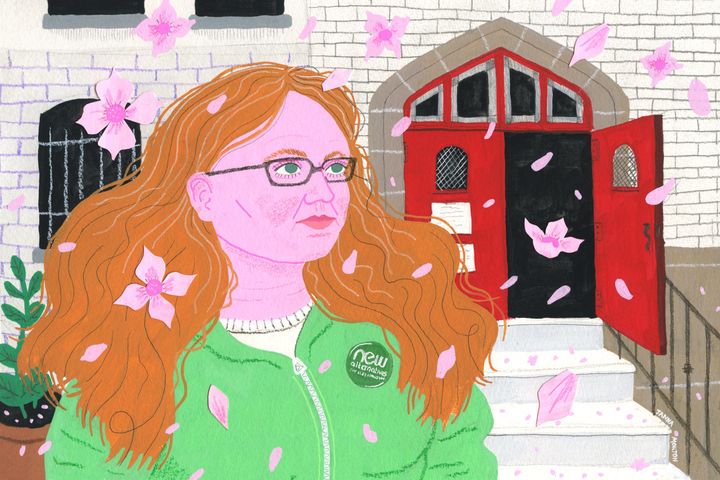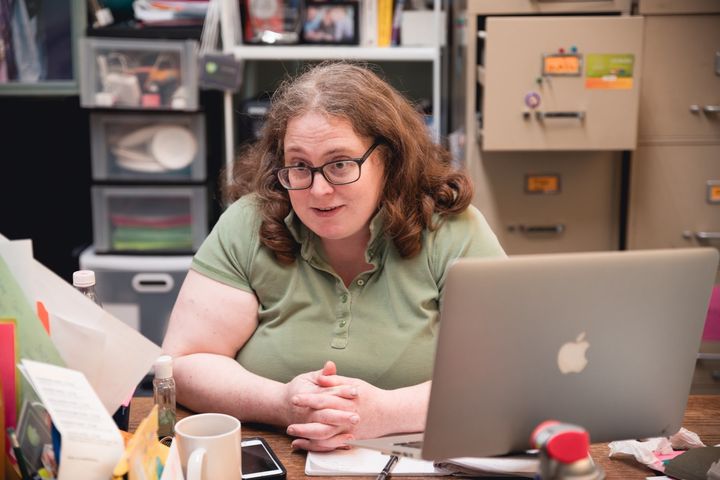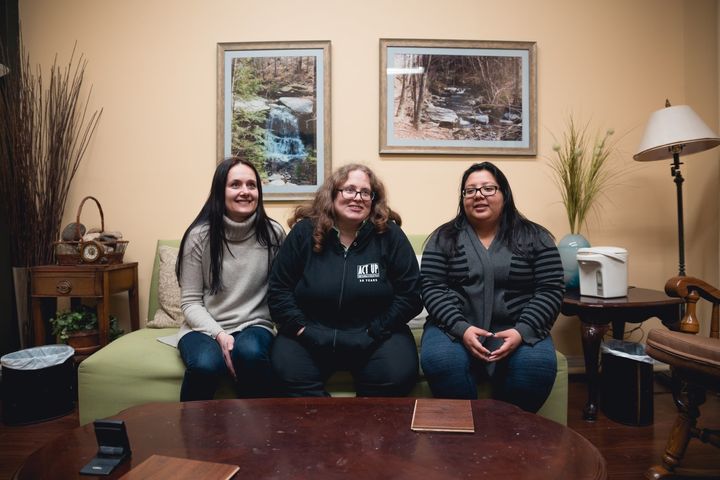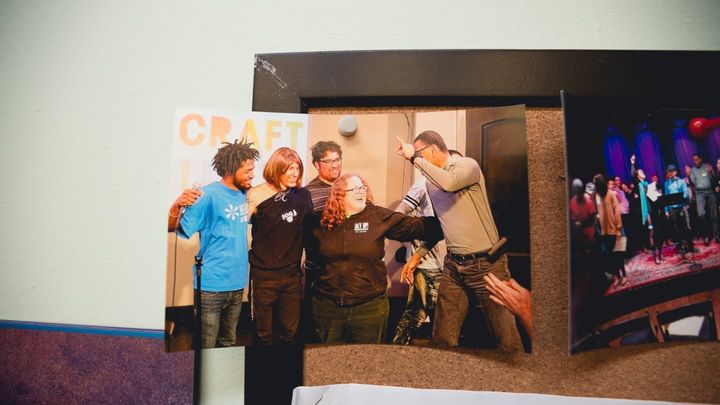
The bright red double doors of the Metro Baptist Church on West 40th Street are a beacon of hope for many displaced LGBTQ youth in New York City. Beyond the crimson-colored entrance and up a narrow set of stairs is Kate Barnhart’s office and the home of New Alternatives, a nonprofit dedicated to helping homeless LGBTQ youth transition into safe, stable adult lives. Through the organization, Barnhart and her small team work tirelessly to help hundreds of displaced teens by offering them everything from warm meals to life-skills training.
LGBTQ youth make up almost 40 percent of the homeless youth population in New York City. Many of them are forced out by homophobic relatives, or are fleeing from conservative communities where they don’t feel safe. Because of the city’s lack of affordable housing and cramped shelters, they often end up living on the streets. Fortunately, many find their way to Barnhart at New Alternatives.
To share Barnhart’s inspiring story, we’ve partnered with TIAA and its TIAA Difference Maker 100 program to honor individuals who are making a positive impact in the nonprofit community.

Barnhart was raised in downtown Manhattan by activist parents. As a toddler, she was already attending marches and protests, which exposed her to the LGBTQ community’s fight for equal rights at an early age. “My dad took me to my first Pride march in a stroller,” Barnhart recalled. “That was at a time when there weren’t gay families really, so people were very surprised to see a child there.”
Barnhart’s own activism started when she was a teenager in the late 1980s while the AIDS crisis was devastating the LGBTQ community. As one of the only out students at her high school, Kate was often considered a resource by her LGBTQ friends. To help educate them about issues like AIDS, she created peer-teaching groups.
At age 15, she joined the activist coalition ACT UP. During a sit-in demanding government action on AIDS, she was arrested for the first time. When hundreds of New Yorkers came out to support her and her fellow protesters, she realized her potential to make a difference in her community.
Throughout high school and after college, Barnhart worked with youth programs and homeless shelters, such as Sylvia’s Place, one of the earliest LGBTQ shelters in the city. Through her different roles, she noticed that the existing services were not meeting the needs of homeless LGBTQ individuals. Specifically, there were no real long-term assistance programs, which meant it was hard for those looking for help to make any real progress.
“Clients were just constantly starting over,” Barnhart explained. “A lot of these shelters and programs are limited to 90 days or six months, but even six months isn’t enough time to start to tackle these huge issues. It is wasted effort because if you start the process with someone, but don’t see it through to the end, what is the point?”
This is why in October 2008, she founded New Alternatives, a nonprofit that could help meet the specific needs of displaced LGBTQ youth. “In the beginning, it was improvisation,” Barnhart explained. “There were needs that needed to be met. And now that I am 42, I’ve realized I am always throwing myself into these holes where things need to be met.”
When Ramon Leclerc found himself struggling to find housing as a teen, he reached out to Barnhart for help. He had aged out of foster care and reached the time limit at another youth shelter.
“I was afraid of going into the male Department of Homeless Services system because I have mild cerebral palsy, and I thought I would be a target in the shelter,” said Leclerc, who is now 31. Barnhart not only found him housing, but set him up with tutors, helped him purchase his college textbooks and eventually made him a staff member at New Alternatives.
Due to a rapidly growing population and extreme income inequality, over 60,000 people in New York City are homeless, and LGBTQ-identifying young people remain some of the most marginalized. In comparison to their heterosexual peers, they are more likely to experience sexual assault, violence, trauma and substance abuse, which is why New Alternatives’s approach is so critical.
The nonprofit started with weekly family-style dinners at Middle Collegiate Church in the East Village to ensure that young people living on the streets could get a warm, nutritious meal. But it has since evolved into a full, comprehensive program. Barnhart’s knowledge of everything from clinical psychology to politics has helped make New Alternatives an organization that is able to address young people’s past traumas, but also give them the tools they need in order to have successful futures.

Today New Alternatives offers a range of resources like weekly life-skills classes on topics from HIV prevention to anger management; as well as case management counseling. It even offers community-building activities like beach and camping trips, and a secure place that they can have mail delivered.
Since many LGBTQ teens who come to New Alternatives were forced out of their homes, they often don’t have items like their birth certificates or social security cards, or a permanent address to send them to. But important documents like these are often necessary for creating long-term stability, like enrolling in school or starting a new job.
Even though New Alternatives is based in New York City, it helps people who come from all over the world. Its diverse client group ranges in age from 16 to 24, with the majority identifying as male. Since most social services prioritize women and families, men can be more prone to homelessness.
Many of the clients suffer from serious mental illnesses, and around 30 percent are living with HIV. They are also primarily people of color. While other organizations can cast those aside who may be considered “difficult” because of issues like severe mental illness, Barnhart looks for ways to connect through their experiences.
“They have a very strong relationship with Kate,” Stasa Jarosz, one of New Alternatives’s student interns, said. “She works with them from beginning to end, and they can leave with the comfort that someone actually listened to them and gave them advice.”
It’s hard to keep track of the exact number of people New Alternatives works with on a regular basis because they tend to go back and forth from active to inactive. But last year, the organization undertook 1,692 case management sessions and served 1,808 dinners to around 400 different clients.
The Sunday dinners, served in the basement of the Metro Baptist Church, are a popular gathering spot. Not just because they offer a place where people can eat, but because it gives them an opportunity to connect.
“I think the family aspect is really important,” Barnhart said. “If the clients screw up, they don’t just fall through a trapdoor. They know they can come back and say, ‘All right, I screwed up,’ and I can say, ‘All right, let’s get back on track.’”

New Alternatives relies on a very small budget, which can be trying on Barnhart. But without government funding, New Alternatives has the freedom to work without red tape unlike other organizations. To keep things running, the nonprofit relies on private grants, individual donors and fundraising events. It also calls on its network of volunteers to do everything from cooking to tutoring.
If Barnhart finds someone needs additional assistance, she sends out a mass email to her list of nearly 1,000 volunteers to see who can step in. If a client has a time-sensitive need, like they need a uniform for a new job or a mattress for an apartment they just moved into, she has what she calls an angel list.
“It is a list of donors who have agreed to receive specific emergency requests,” said Barnhart, who recently called one of the “angels” for a bus ticket for a client who was stranded in Florida. “Over time, I have gotten to know the kinds of requests each angel will take. This one guy is the bus ticket man, so I will send travel requests to him [for instance].” She added, “Where there’s a will, there’s a way.”
In the time she isn’t busy with New Alternatives, Barnhart is actively advocating for additional resources for homeless LGBTQ youth, from more permanent housing options to increased support for those with mental illnesses. One of her current initiatives is creating a host home program, where New Yorkers can give homeless youth a place to sleep, to supplement the available shelter beds.
As Barnhart looks to the future, her goal is to keep expanding New Alternatives as her resources allow. In addition to the five part-time staff members and interns, she would like to hire a social worker and a psychiatrist. While growth might take a while, Barnhart wants to make sure she can maintain the same attention and care to each client, so the work of New Alternatives can have lasting effects on the homeless LGBTQ community.
“I wanted to create a safe landing pad for kids who were falling through the system and I think we’ve been able to accomplish that,” Barnhart said. “There has been huge progress, but there is a long way to go.”

All over the United States, people like Kate Barnhart are working to make positive and lasting change in the lives of others. We’ve partnered with TIAA to celebrate its centennial — 100 years of helping people doing good do well — and to put the spotlight on visionaries whose inspirational work is shaping the next century. To learn more about recommending someone, go here: www.TIAAdifferencemaker100.org.
Words by Erica Euse; Photos by Kenya Bravo
